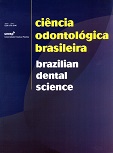Compatibilidade entre cimento resinoso quimicamente ativado e adesivos simplificados associados a um catalisador universal
DOI:
https://doi.org/10.14295/bds.2005.v8i2.388Abstract
Objetivos: Os objetivos deste trabalho foram avaliar a resistência de união de adesivos simplificados a um cimento resinoso quimicamente ativado, assim como o efeito de um catalisador universal sobre estes valores, e a associação entre o pH dos adesivos e a resistência de união com o cimento resinoso. Materiais e Métodos: Foi confeccionado um bloco do cimento C&B Cement (Bisco), sendo o adesivo aplicado sobre este, seguido da construção de um segundo bloco. Todos os adesivos simplificados foram utilizados com e sem o catalisador BondLink (Den Mat). Estes foram embutidos em resina acrílica, mantidos em recipientes à prova de luz por 24 horas, sendo então seccionados para obtenção de palitos com aproximadamente 0,49mm2. Ao total foram obtidos 25 corpos-de-prova para cada grupo. O pH de cada adesivo foi medido com fitas medidoras. A resistência de união foi verificada por meio do teste de flexão de três pontos que foi realizado em máquina de ensaio universal EMIC DL-2000. Resultados: Os valores médios de resistência de união (MPa) para cada adesivo, sem e com a aplicação do BondLink, foram os seguintes, respectivamente: Scotchbond Multi Uso (111,17); Single Bond (103,49 e 74,66); One Step Plus (105,94 e 72,88); Clearfil SE Bond (106,27 e 39,82); AdheSE (101,27 e 59,38); Adper Prompt L-Pop (17,16 e 46,47). Conclusões: Houve incompatibilidade somente entre o adesivo Adper Prompt L-Pop e o cimento. O catalisador BondLink foi eficiente apenas para este adesivo. A união adesivo/cimento foi influenciada pelo pH dos adesivos.Downloads
Downloads
Published
How to Cite
Issue
Section
License
Brazilian Dental Science uses the Creative Commons (CC-BY 4.0) license, thus preserving the integrity of articles in an open access environment. The journal allows the author to retain publishing rights without restrictions.
=================




























